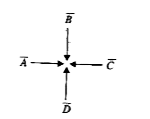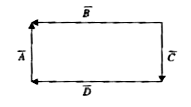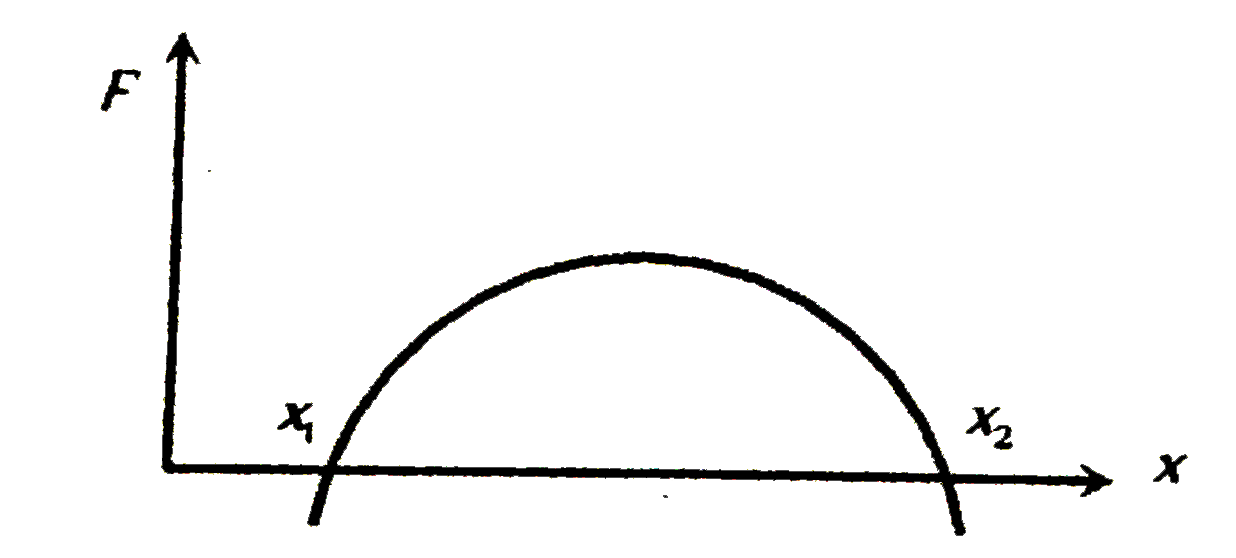The vectors A , B , C , D represents the forces acting on a body. Which one of the following Fig. 15.14.5. indicates that the body is in equilibrium.




The correct Answer is:B
To determine which configuration of the vectors A, B, C, and D indicates that the body is in equilibrium, we will analyze each option systematically.
1. Understanding Equilibrium:
A body is in equilibrium when the net force acting on it is zero. This means that the vector sum of all forces must equal zero.
2. Analyzing Option 1:
- In this option, all vectors A, B, C, and D are acting at a single point.
- For the body to be in equilibrium, the vectors must either be equal in magnitude and opposite in direction or must cancel each other out.
- Since we are not given any information about the magnitudes of A, B, C, and D being equal, we cannot conclude that they cancel each other out.
- Conclusion: This option does not indicate equilibrium.
3. Analyzing Option 2:
- Here, we will use the parallelogram law of vector addition to find the resultant of A and B.
- Let’s denote the resultant of A and B as R1.
- Next, we find the resultant of B and C, which we denote as R2.
- If R1 and R2 are equal in magnitude and opposite in direction, then the net force will be zero.
- Since the problem states that the magnitudes of the resultant vectors are equal and opposite, we conclude that the net force is zero.
- Conclusion: This option indicates that the body is in equilibrium.
4. Analyzing Option 3:
- We apply the parallelogram law to find the resultant of A and B, which we denote as R3.
- Then we find the resultant of D and C, denoted as R4.
- If R3 and R4 do not cancel each other out, the net force will not be zero.
- Conclusion: This option does not indicate equilibrium.
5. Analyzing Option 4:
- Again, we apply the parallelogram law to find the resultant of B and C, denoted as R5.
- We also find the resultant of D and A, denoted as R6.
- If R5 and R6 do not cancel each other out, the net force will not be zero.
- Conclusion: This option does not indicate equilibrium.
Final Answer:
After analyzing all options, we conclude that Option 2 indicates that the body is in equilibrium.
A body is in equilibrium when the net force acting on it is zero. This means that the vector sum of all forces must equal zero.
- In this option, all vectors A, B, C, and D are acting at a single point.
- For the body to be in equilibrium, the vectors must either be equal in magnitude and opposite in direction or must cancel each other out.
- Since we are not given any information about the magnitudes of A, B, C, and D being equal, we cannot conclude that they cancel each other out.
- Conclusion: This option does not indicate equilibrium.
- Here, we will use the parallelogram law of vector addition to find the resultant of A and B.
- Let’s denote the resultant of A and B as R1.
- Next, we find the resultant of B and C, which we denote as R2.
- If R1 and R2 are equal in magnitude and opposite in direction, then the net force will be zero.
- Since the problem states that the magnitudes of the resultant vectors are equal and opposite, we conclude that the net force is zero.
- Conclusion: This option indicates that the body is in equilibrium.
- We apply the parallelogram law to find the resultant of A and B, which we denote as R3.
- Then we find the resultant of D and C, denoted as R4.
- If R3 and R4 do not cancel each other out, the net force will not be zero.
- Conclusion: This option does not indicate equilibrium.
- Again, we apply the parallelogram law to find the resultant of B and C, denoted as R5.
- We also find the resultant of D and A, denoted as R6.
- If R5 and R6 do not cancel each other out, the net force will not be zero.
- Conclusion: This option does not indicate equilibrium.
After analyzing all options, we conclude that Option 2 indicates that the body is in equilibrium.
Topper's Solved these Questions
- BOOK - ICSECHAPTER - COMPETITION CARE UNITEXERCISE - OBJECTIVE QUESTIONS FROM PREVIOUS IAS EXAMINATIONS50videos
COMPETITION CARE UNIT
- BOOK - ICSECHAPTER - COMPETITION CARE UNITEXERCISE - WAVES98videos
COMPETITION CARE UNIT
- BOOK - ICSECHAPTER - CIRCULAR MOTION EXERCISE - MODULE 2 (FROM ROTATIONAL KINETIC ENERGY , WORK ,POWER)24videos
CIRCULAR MOTION
- BOOK - ICSECHAPTER - DIMENSIONSEXERCISE - SELECTED PROBLEMS (FROM CONVERSIONS OF ONE SYSTEMS OF UNITS INTO ANOTHER)9videos
DIMENSIONS
Similar Questions
Knowledge Check
- Question 1 - Select One
During rest, the metabolic needs of the body are at their minimum. Which of the following Is indicative of this situation ?
ARate of breathingBO2 intake CO2 outputCPulse rateDAll of these
Which of the following is a true nut?
View SolutionOn applying force to the centre of mass of a body one of the following is present in the body?
View SolutionThe force acting on a body moving along x-axis variation of the particle particle shown in the figure. The body is in stable equilibrium at
 . View Solution
. View SolutionThe force acting on a body moving along x-axis variation of the particle particle shown in the figure. The body is in stable equilibrium at
 . View Solution
. View SolutionWhich of the following sets of forces acting simultaneously on a particle keep it in equilibrium?
View SolutionThe force acting on a body moving along x -axis varies with the position of the particle as shown in the fig. The body is in stable equilibrium at.
 View Solution
View SolutionThree forces are acting on a body to make it in equilibrium , which set can not do it ?
View Solution
